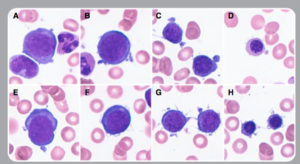A group from Japan has found that the deformation of erythroblasts seen in transient erythroblastopenia of childhood is caused by HHV-6. Erythroblasts are progenitor cells in the bone marrow, necessary for the production of red blood cells. Bone marrow analysis showed that HHV-6 infection coincided with erythroblastopenia with deformities that included pseudopodia (temporary cytoplasmic extensions) in 38%, filamentous changes on the cell surface in 33%, and both abnormalities in 19%.

HHV-6 infection caused cytoplasmic extensions (A-D) and filamentous changes (E-H) in erythroblasts. Source: Blood, American Society of Hematology
Transient erythroblastopenia of childhood (TEC) is a temporary red cell aplasia that occurs in young children, in the same time frame as primary infections. The cause is considered unknown, although viral infections are suspected, and parvovirus B19, enterovirus and HHV-6 have been documented in previous case reports.
A previous report of HHV-6 in TEC came two decades ago from the University of Pittsburgh. Investigators examined the bone marrow of 14 young children with hematologic disorders and found HHV-6 in the children with TEC but not in the children who did not have TEC (Penchansky 1997).
The investigators from Nagano Children’s Hospital in Japan are the first to show distinct erythroblast deformation by HHV-6 in TEC.
Read the full paper here.

